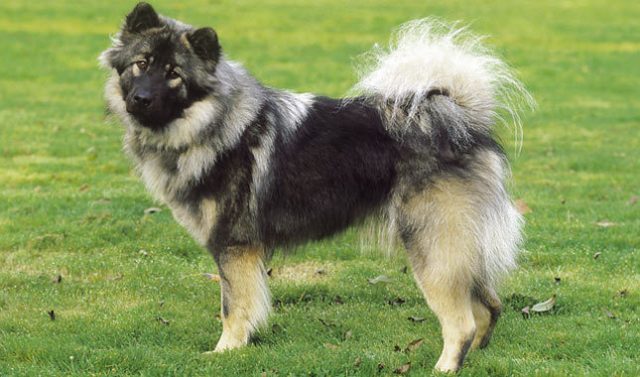Type the name of the breed you're looking for below
[wpdreams_ajaxsearchlite] Don't see the breed your're looking for? Click here and let us know!
Breed Characteristics
1 paw - breed exhibits the least amount of this characteristic
5 paws - breed exhibits most amount of this characteristic
Eurasier
| Other Names | Eurasian, Eurasian Dog |
| Country of Origin | Germany |
| Weight | Males: 50 - 70 lbs. (23 - 32 kg) Females 40 - 60 lbs. (18 - 26 kg) |
| Height (at withers) | Males: 20 - 24 in. (52 - 60 cm) Females: 16 - 18 in. (48 - 56 cm) |
| Coat | Eurasier's have a thick undercoat and medium-long, loosely lying guard hair all over the body, with a short coat on the muzzle, face, ears, and front legs. The tail and the back of the front legs (feathers) and hind legs (breeches) should be covered with long hair. The coat on the Eurasier's neck should be slightly longer than on the body, but not forming a mane. |
| Colour | It comes in different colours: fawn, red, wolf-grey, solid black, and black and tan. All colour combinations are allowed, except for pure white, white patches, and liver colour. |
| Litter Size | 4 - 8 puppies, average 6 |
| Life Span | 10 - 13 years |
| Origin & History | Eurasiers originated in Germany in 1960, when the founder, Julius Wipfel, set out together with Charlotte Baldamus and a small group of enthusiasts to create a breed with the best qualities of the Chow Chow and the Wolfspitz. The initial combination of the breeds resulted in what was first called "Wolf-Chow" and then, twelve years later, after crossing with a Samoyed, was renamed "[Eurasier]" (Eurasian) and recognized by the FCI in 1973. Nobel Laureate Konrad Lorenz obtained a Eurasier puppy from Charlotte Baldamus, Nanette vom Jaegerhof, whom he called "Babett". He thought her character was the best he had ever known in a dog. Today, unethical breeders sometimes try to pass off a Keeshond/Chow Chow mix as a Eurasier. While they are genetically similar, these mixes cannot be classified as Eurasiers. Eurasiers are still a comparably young breed. The three Eurasier Clubs are in the German Kennel Club VDH / FCI —EKW, KZG, and ZG—therefore strongly direct and supervise breeding in Germany. A group of very dedicated Eurasier Clubs have joined together in the International Federation for Eurasier Breeding (IFEZ) in the FCI. Eurasier puppies bred according to these sound IFEZ guidelines receive an IFEZ certificate. The Eurasier breed was recognized by the Canadian Kennel Club (CKC) in 1995 as a member of Group 3 (Working Dogs). The Kennel Club announced in December 2012 that with effect from April 1, 2013, the Eurasier breed will transfer from the imported register to the breed register. |
| Personality | An excellent companion dog, the Eurasier is calm, quiet, even tempered and friendly. Watchful and alert. Affectionate and loyal toward its family, yet reserved and shy with strangers, without being timid or aggressive. Socialize well when young with other dogs and people. This breed forms a strong bond with its family. It is intelligent and quick to learn. Consistent training should start early. Responds well to training, however one must understand the breed in order to train it successfully. This breed does not respond well to ruthless discipline, you must use soft reprimand; firm, but not harsh. Proper human to canine communication is a must. They can get bored if the training becomes repetitive. If they sense the owners are meek or passive they may become stubborn. Many Eurasiers excel at agility. Playful, a stable-minded Eurasier will get along well with children who have good pack leader skills. They are not guard dogs, but make good watchdogs, barking at things that are unfamiliar to them. This breed rarely barks without good reason; however, as with any breed, some are more vocal than others and you need to communicate to them when enough is enough. Do not allow them to bark at you when they want something as that is a dog a displaying dominant behavior. Usually does well with other dogs. |
Care Requirements
| Health | Eurasiers are generally healthy dogs, though a small gene pool in the breed's early years has led to some hereditary diseases being seen occasionally. Known issues include hip dysplasia, luxating patella, and hypothyroidism, as well as eyelid and lash disorders such as distichiae, entropion, and ectropion. |
| Grooming | The Eurasier's thick coat should be brushed weekly to keep it from becoming matted and coarse. During seasonal heavy-shedding periods, they should be brushed more frequently. |
| Exercise | A good amount of exercise is a must. This breed needs daily long walks, where the dog is made to heel beside or behind the human holding the lead, as instinct tells a dog the leader leads the way, and that leader needs to be the human. They should have a safe enclosed area to run free. |
| Other Considerations | Does not do well in an outside kennel, chained up or confined to one room. They do best when they are part of the family. If they are left isolated and/or left alone for long periods of time they can become depressed. Calm and quiet indoors, active and playful outdoors, they enjoy some good action. |



